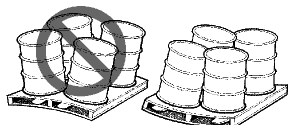How to Load a Forklift
Giving instructions on how to load a forklift to forklift owners and operators may seem like telling an experienced driver how to drive a car. However, just as experienced drivers pick up bad habits over the years, so do forklift operators. A little refresher course in the basics of loading a lift truck can make the difference between a safe and prosperous workplace and an expensive accident or serious injury.
Don’t Exceed Your Load Limit
 All forklifts have load limits that are stated clearly on their data plates. The load limit on the data plate will be for standard pallet loads that are placed squarely on the forks and carried close to the ground. If you carry a heavy load that’s balanced precariously on the ends of the forks or a raised load, your load limit decreases exponentially and can cause an accident. In extreme cases, the forklift can tip forward, but even if it seems to be balanced, the extra weight in the front of the lift truck can cause a reduction in steering control because the rear wheels are no longer firmly in contact with the ground.
All forklifts have load limits that are stated clearly on their data plates. The load limit on the data plate will be for standard pallet loads that are placed squarely on the forks and carried close to the ground. If you carry a heavy load that’s balanced precariously on the ends of the forks or a raised load, your load limit decreases exponentially and can cause an accident. In extreme cases, the forklift can tip forward, but even if it seems to be balanced, the extra weight in the front of the lift truck can cause a reduction in steering control because the rear wheels are no longer firmly in contact with the ground.
How to Insert Forks
The mast should be in the upright position before you insert the forks into a pallet. The forks should be spaced apart to maximise stability and inserted at equal distances from the center stringer. When working in a tight area, don’t allow the tips of the forks to protrude too far from the edge of the pallet. Because the ends of the forks won’t be visible, they could catch on something and cause an accident.
Carry a Stable Load
An unstable load is very unforgiving. If you have to brake suddenly, it could easily topple over. Turning even at normal speed on a flat surface could be all it takes for the load to tip over as you turn. Many forklift accidents occur after operators repeatedly push the limits of load stability in order to save a few minutes’ time. They’ve done it successfully a hundred times before, but on just one occasion when they have to stop quickly or swerve around an unexpected obstacle, it’s enough to lose the entire load. At best it will be a costly mistake. At worst, it can cause a serious injury or fatality.
Your load is only as stable as the pallet it is resting on. Inspect your pallets periodically. Repair damaged pallets immediately and discard pallets that cannot be repaired.
Raising the Load
Keep these things in mind when raising or lowering a load:
- Make sure you have adequate overhead clearance before raising your load.
- Your forklift should be stopped and braked before you raise or lower a load.
- Lift loads straight up or tip the mast back slightly.
- Do not lift a load that extends beyond the backrest unless there is no chance that it can tip back towards the forklift operator
- The operator should be in the cabin when a load is in the raised position.
As simple as these basic skills are to learn and follow, it’s all too easy to take a chance “just once.” It’s that one time that leads to bad habits and ultimately to a forklift accident.

